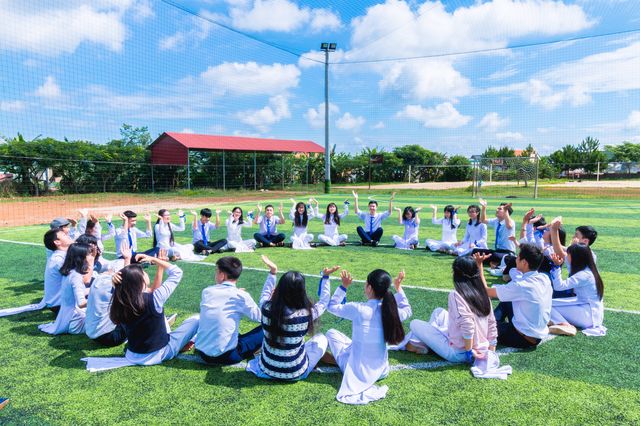Gathering in circles, it seems, is part of being in a group or community. The group may be a meeting of business executives or a gathering of small children around a teacher; it may be family reunion or a therapy group. It might be a community of monks, or a community called church. No matter what the nature of the group and the purpose for the meeting, often they will gather in a circle.
The reasons for these gatherings are as diverse as the communities themselves, but there seems to be something powerful, almost universal, about a group of people coming together in a circle. Of course, the significance of this circle-gathering ritual is based on (1) what happens, what we do in the circle, and (2) the pictures of ourselves, of others, and of the world, that we bring with us into the circle.
There are many, many pictures of humanity and selfhood. Every philosophy and religion have a picture of who we are as individuals and communities. Quite often these pictures consist of an ideal individual and community, how that ideal becomes distorted, and what the individual or community needs to do recapture that ideal.
Take the Christian faith for example, or at least one understanding of the Christian faith. Many Christian traditions think of humanity as fallen. There was a time when we lived in open and right relationship with God, but with the coming of sin, that time has past. Now, we are living out the consequences that go with being fallen people. This fallen-ness is pervasive. It is part of our identity; it is descriptive of who we are. This pervasive fallen-ness is overcome by God’s work of conversion and salvation. This fallen-ness and the need for salvation influences our understanding of who we are, what the world is like, and how we can live meaningfully in the world.

In his book A Hidden Wholeness, Parker Palmer offers his own images of humanity and selfhood. These images will give guidance and shape to what he says about how we can live meaningfully in the world; they will guide and shape his understanding of what it means for communities to gather in circles.
Palmer does not see humanity as fallen. Instead, he speaks of a “wholeness” that lives within each person. As his title suggests, this inherent wholeness can be “hidden”, and he talks about how this hidden-ness happens throughout life. But while hidden, that doesn’t change the fact that this wholeness is real; it is the core of who we are as persons. So, according to Palmer, when we choose to act in ways that are sinful, we are not choosing for an inherent fallen nature; instead, we are choosing against an inherent wholeness. The goal of life is to find this “hidden wholeness” and express it in real and meaningful ways.
While Parker does not believe that humanity is fallen, he certainly understands that we have “an endless capacity for self-absorption and self-deception” (22). It is this capacity that keeps us from experiencing the fullness of life that comes from the expression of this hidden wholeness. It is this capacity that calls for the presence of others, a community, to bring forth this hidden wholeness.
Palmer proposes a specific kind of community, a “circle of trust,” that allows this wholeness to emerge and animate our lives. Palmer states that these circles are “rooted in two basic beliefs. First, we all have an inner teacher whose guidance is more reliable than anything we can get from a doctrine, ideology, collective belief system, institution, or leader. Second, we all need other people to invite, amplify, and help us discern the inner teacher’s voice” (25-26).
Palmer gives an evocative and inviting image that capture the depth and wonder of this inner teacher that he equates with the soul. He talks about the soul as a wild animal that needs a quiet and safe place to emerge:
What sort of space gives us the best chance to hear soul truth and follow it? A space defined by principles and practices that honor the soul’s nature and needs. What is the nature, and what are those needs? My answer draws on the only metaphor I know that reflects the soul’s essence while honoring its mystery: the soul is like a wild animal.
Like a wild animal, the soul is tough, resilient, resourceful, savvy, and self-sufficient. It knows how to survive in hard places…Yet despite its toughness, the soul is also shy. Just like a wild animal, it seeks safety in the dense underbrush, especially when other people are around. If we want to see a wild animal, we know that the last thing we should do is go crashing through the woods yelling for it to come out. But if we will walk quietly into the woods, sit patiently at the base of a tree, breathe with the earth, and fade into our surroundings, the wild creature we seek might put in an appearance. We may see it only briefly and only out the corner of an eye—but the sight is a gift we will always treasure as an end in itself (58-59).
Palmer suggests that it takes a unique setting and a unique stance for this hidden teacher, this wild animal of the soul, to emerge. That setting and stance are groups that he calls “circles of trust.” The rest of the book is given to two tasks: (1) Exploring some theoretical and theological ideas that form the basis of these circles of trust, and (2) Offering some practical suggestions about how to create and implement these circles of trust.

Palmer believes that a circle of trust can be one individual or a group. Circles of trust can evolve among our friends, family, and community, or they can be developed intentionally. Regardless of their makeup, these circles combine an unconditional love or regard with hopeful expectancy; this combination creates a space that both safeguards and encourages the inner journey. Palmer asks,
What exactly do we trust in a circle of trust? Four things, at least:
- We trust the soul, its reality and power, its self-sufficiency, its capacity to speak truth, its ability to help us to listen and respond to what we hear.
- We trust each other to have the intention, discipline, and good-will to create and hold a space that is safe enough to welcome the soul.
- We trust the principles and practices that create such a space and safeguard the relationships within in, aware that the pull of conventional culture is persistent and can easily tug us toward behaviors that will scare the shy soul away.
- We trust that welcoming the soul with no “change agenda” in mind can have transforming outcomes for individuals and institutions. (66)
Some of the practical suggestions for creating and participating in a circle of trust express its unique stance and some of its potential for transformation. For example, in the circle the invitation to participate is always an open one; there is no expectation for a person or the group to speak or respond in a certain way, at a certain time, or at all.
Another unique feature of the circle of trust is approaching the truth “told slant.” Instead of running headlong into reflections about specific personal problems or concerns, the circle uses a “third object” like a poem, a story, or a work of art. As this object is shared with the circle, members are encouraged to let responses be evoked by the soul’s interaction with this resource. This inner teacher will know the connections it needs to make and the insights it needs to gain.
Finally, Palmer talks about “no fixing, no saving, no advising, no setting each other straight” (114). He gives excellent suggestions on the use of comments, questions, silence, and humor as a way to create the emotional, physical, and spiritual space for the inner teacher of the soul to emerge and share its wisdom. For example, in the circles, whenever anyone speaks, they look to and speak to the center of the circle, instead of to one another. Everything shared is there in the middle of the circle, and the one seeking guidance uses that shared wisdom in whatever way seems helpful.
For me, the bases of Palmer’s beliefs about and practices of circles of trust are deeply theological and spiritual. For example, it is easy for me to equate the image of the soul and the inner teacher with the idea of God’s spirit dwelling and working within us. I also connect Palmer’s ideas with the biblical assertions that we are made in the image of God and that part of this image involves us becoming “participants of the divine nature” (2 Peter 1:4).

I also believe that Palmer’s work has something to say to us about the church as a community. Community is one of those words that is used a lot when we talk about church. And yet, the church is a very specific kind of community. We are a covenant community. We are a called community.
We are far more than a group of like-minded individuals who believe the same things, act the same way, and enjoy getting together weekly for worship and other kinds of social interaction. As a called and covenant community, we accept the challenge, and the privilege, to live out the welcoming and accepting grace of God. All of these words are broad and sweeping statements about the church as community, but how do we live out these statements in tangible and specific ways? I believe that Palmer’s ideas about circles of trust are one way for us to do that. Circles of trust honor who we are called to be as a community, and I think any community could be transformed by living out some of the practices that Palmer suggests.
